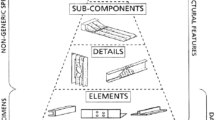Abstract
Specific properties such as the stiffness and strength-to-weight ratio of the sandwich structure have a great impact on aircraft performance. The current research introduces a design methodology to replace the honeycomb core. Four configurations of structure members with a corrugated core were utilized. The skin sheets were made from pre-preg carbon fiber composite lamina and the corrugated cores were made from the same composite with three different thicknesses in addition to a corrugated core of pre-preg fiberglass lamina. Also, other configurations were assembled boxes from the separate structure members. All configurations were subjected to edgewise compression testing. The failure modes combined with the experimental results demonstrate the importance of design optimization in developing the sandwich structure properties. Changing from open-contour structures to closed-contour ones, utilizing different core materials with good wettability, and controlling the load direction enhance the compression capacity-to-weight ratio of the structural composites and improve their fracture resistance.
Similar content being viewed by others
References
A. Gilioli, C. Sbarufatti, A. Manes and M. Giglio, Compression after impact test (CAI) on NOMEX™ honeycomb sandwich panels with thin aluminum skins, Composites: Part B, 67 (2014) 313–325.
T. Southward, G. D. Mallinson and K. Jayaraman, Buckling of disbonds in honeycomb-core sandwich beams, Journal of Sandwich Structures and Materials, 10(3) (2008) 195–216.
B. Ganesh, B. V. Kumar and D. Muppala, Design and structural analysis of aircraft floor panel, International Journal of Advanced Engineering and Global Technology, 3(12) (2015) 1451–1460.
I. Blundell, R. Hilliker, J. Mano, E. Elghandour and F. Kolkailah, Optimum design of trapezoidal corrugated composite structures, Proc. of the Composites and Advanced Materials Expo: CAMX 2017, Orlando (2008) 602–615.
A. Lindström, Strength of sandwich panels loaded in in-plane compression, Licentiate Thesis, KTH Royal Institute of Technology, Stockholm, Sweden (2007).
S. N. Akour and H. Z. Maaitah, Effect of core material stiffness on sandwich panel behavior beyond the yield limit, World Congress on Engineering, London, U.K. (2010).
S. Kazemahvazi, J. Kiele, B. Russel, V. Deshpande and D. Zenkert, Impact properties of corrugated composite sandwich cores, 9th International Conference on Sandwich Structures (2010) 1–10.
M. I. Avó de Almeida, Structural behavior of composite sandwich panels for applications in the construction industry, M.Sc. Thesis, Instituto Superior Técnico, Lisbon, Portugal (2009).
C. Villa dos Santos, D. R. Leiva, F. R. Costa and J. A. R. Gregolin, Materials selection for sustainable executive aircraft interiors, Materials Research, 19(2) (2016) 339–352.
A. Boccaccio, C. Casavola, L. Lamberti and C. Pappalettere, Structural response of polyethylene foam-based sandwich panels subjected to edgewise compression, Materials, 6 (2013) 4545–4564.
C. Thill, J. A. Etches, I. P. Bond, K. D. Potter and P. M. Weaver, Corrugated composite structures for aircraft morphing skin applications, 18th International Conference of Adaptive Structures and Technologies, Ottawa (2007).
W. L. Ko and R. H. Jackson, Combined Compressive and Shear Buckling Analysis of Hypersonic Aircraft Structural Panels, NASA Technical Memorandum 4290, National Aeronautics and Space Administration (1991).
L. S. Babu and H. K. Shivanand, Mechanical characterization of pu based sandwich composites with variation in core density, International Journal of Materials Science and Applications, 4(4) (2015) 277–282.
E. Elghandour and N. Elzayady, Comparison between honeycomb and composite corrugated cores in sandwich panels under compression loading, International Journal of Sustainable Material and Structural Systems, 5(1/2) (2021) 179–192.
A. M. Elhabak, A. Nabil, M. Adly and N. Elzayady, Behavior of hybrid composite structure under low impact velocity, Journal of Engineering and Applied Sciences, 15(14) (2020) 2772–2780.
A. Vlot, Impact properties of fiber metal laminates, Composite Engineering, 3 (1993) (10) 911–927.
N. Elzayady and E. Elghandour, Compression behaviour of composite sandwich panels with corrugated core, International Journal of Sustainable Materials and Structural Systems (2021) (online-first).
S. Kazemahvazi, D. Tanner and D. Zenkert, Corrugated alcomposite sandwich structures, part 2: Failure mechanisms and experimental programme, Composites Science and Technology, 69(7–8) (2008) 920–925.
N. Elzayady and E. Elghandour, Compression capacity of corrugated core hybrid composite sandwich structure, Key Engineering Materials, 821 (2019) 47–53.
Acknowledgments
All Mechanical Engineering Department Team (California Polytechnic State University, U.S.A.) are gratefully appreciated for their support and permission for manufacturing and testing the samples of the current investigation as a part of a large effort for enhancing the compressive capacity of sandwich structures.
Author information
Authors and Affiliations
Corresponding author
Additional information
Nagwa Elzayady is an Associate Professor of Mechanical and Aerospace Engineering at the Institute of Aviation Engineering and Technology, Giza, Egypt (IAET). She received her M.Sc. and Ph.D. in Mechanical Design and Production Engineering from Cairo University in 2001 and 2012, respectively. Her expertise is in engineering materials analysis, composite material, manufacturing, and testing. Ten years of teaching and research experience at Cairo University (2000–2009) and at IAET (2010–2020) and other ten years (1994–2004) of professional experience at the Arab Organization for Industrialization (AOI), Egypt.
E-mail: goga.2008@yahoo.com, h]+2 01022399953.
Eltahry Elghandour is an Associate Professor at Mechanical Engineering Department at California Polytechnic State University, San Luis Obispo (Cal. Poly. SLO), USA. He received his M.Sc. and Ph.D. in Mechanical Design and Production Engineering from Helwan University in 1989 and 1995, respectively. His expertise is in composite materials analysis, manufacturing, fatigue and fracture mechanics, and advanced finite element analysis. Twenty-seven years of teaching and research experience at the university level and nine years of professional experience before coming to Cal. Poly.
E-mail: eelghand@calpoly.edu, Tel: 805-756-1728.
Rights and permissions
About this article
Cite this article
Elzayady, N., Elghandour, E. Design optimization to improve the performance of the aircraft composite structures. J Mech Sci Technol 35, 4381–4388 (2021). https://doi.org/10.1007/s12206-021-0909-1
Received:
Revised:
Accepted:
Published:
Issue Date:
DOI: https://doi.org/10.1007/s12206-021-0909-1




